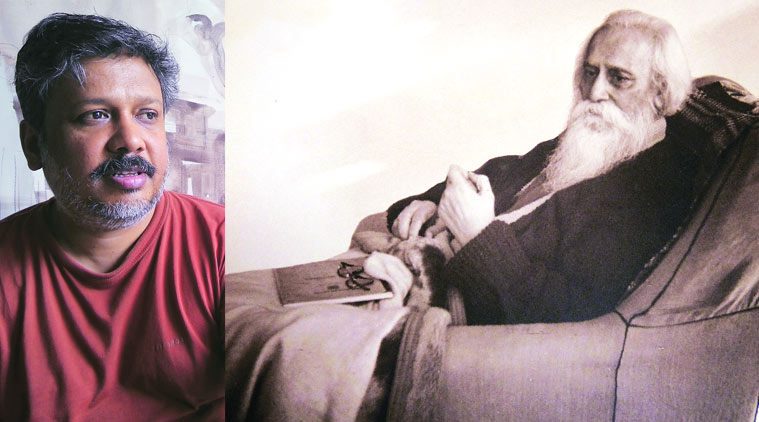Tracing Tagore
An online archive by artist Samit Das presents the life and times of Rabindranath Tagore.
 Samit Das; a portrait of Rabindranath Tagore .
Samit Das; a portrait of Rabindranath Tagore .
In 2011, the large marble halls at the Capital’s Lalit Kala Akademi saw a tribute from an avid admirer to a veteran artist, both well-known. Jorasanko Thakur Bari, Rabindranath Tagore’s home north of Kolkata, and his ideals, had inspired Samit Das to translate the work of the Nobel Laureate into his own. In his hybrid paintings and prints, Das introduced traces of Tagore’s architectural drawings and old maps, and his thoughts that laid the foundation of the Bengal School Art Movement. The exhibition had been in the making for years, as Das puts it. After all, he had been gathering material on Tagore for decades, ever since he was a graduate student in Santiniketan in the ’90s, where he was introduced to Tagore, “the person” by Rani Chanda, wife of Anil Chanda, a close associate of Tagore.
Unlike most other Bengalis of his generation, Das did not grow up on Tagore’s writings or poems. His first exposure to the veteran was in his teens, when he purchased several photographs of renowned Indian personalities, among which was Tagore wearing a robe. It was in Santiniketan that Das delved deeper into his philosophy. While that formed the premise of several of his own works, now 46-year-old Das is sharing his notes and research material on Tagore on his website. The archive built over a period of 20 years, includes Tagore’s portraits and photographs of Tagore House Museum in Kolkata. There are editions of Visva Bharati News (a booklet containing updates on the university), The Visva Bharati Quarterly from 1925 onwards and pages from Roop Lekha (a seminal art journal published during the ’40s and ’50s by All India Fine Arts and Crafts Society). “There is a need for consciousness regarding archives in India, otherwise we would fail to understand the present and move away from the past as well,” says Das, adding, “The Bengal School style was just a name — it was not limited only to Bengal. Abanindranath and his disciples occupied an important place, but this was a huge attempt to build up Indian art and guide it back in the right direction.”
Collected from numerous sources — Kala Bhavana, Tagore House Museum Collection and Victoria & Albert West Kensington Archives among others — the digital archive proposes to provide an insight into major social, political and literary discussions during the period. If Suniti Kumar Chattopadhyay’s book Rabindrasangame Dwipomoy Bharat O Shyamdes informs of the cultural exchange between India and its neighbours at that time, in his letters Swami Vivekananda expresses his regard for Japan. In another letter, Scottish biologist Patrick Geddes expresses his displeasure over “translating the word Visva Bharati to University”. “Tagore’s letters tell us about the intense communication that existed in South East Asia regarding,” notes Das.
While he intends to add to the existing digital archive in the coming months — including uploading rare sketches of Nandalal Bose and photos of Mahatma Gandhi and Rabindranath Tagore — in his Charmwood Village studio, he is working on another set of contemporary work based on archival photographs, to be exhibited at Gallery Espace next year. “Like an art historian studies photographs, I’ll study them from the perspective of an artist. The exhibition will present an artist’s visual documentation,” says Das.
vandana. kalra@expressindia.com
- 01
- 02
- 03
- 04
- 05



























